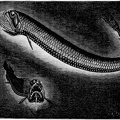M, mouth; S, ciliated groove; T, tentacles. Each tentacle is perforated by a single large aperture.
A fact of some importance that supports this hypothesis, as regards some parts of the ocean at least, is presented by the sea-anemones.
Many of the shallow-water Actinians are known to possess minute slits in the tentacles and disc, affording a free communication between the general body cavity or cœlenteron and the exterior.
In many deep-sea forms the tentacles are considerably shorter and the apertures larger than they are in shallow-water forms. It is difficult to believe that such forms, perforated by, comparatively speaking, large holes, could manage to live in rapidly flowing water, for if they did so they would soon be smothered by the fine mud that composes the floor of all the deep seas. In fact anemones of the type presented by such forms as Sicyonis crassa are only fitted for existence in sluggish or still water.
- Author
- The fauna of the deep sea
By Sydney John Hickson
Published in 1894
Available from gutenberg.org - Posted on
- Tuesday 2 February 2021
- Dimensions
- 905*861
- Tags
- Albums
- Visits
- 711
- Downloads
- 86
 Download Photo
Download Photo





